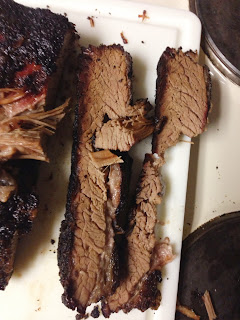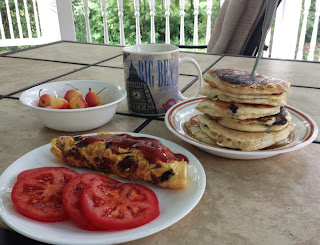I don't just mean "cooking stuff on the grill", no matter what my food icon over to the left would imply. The word "barbecue" seems to have extended its meaning over the years to include grilling, but the older "meat slow cooked in smoke" doesn't necessarily require a full smokehouse to do.
Barbecue does seem to break all the rules when it comes to cooking meat. You often use a cut that's not exactly "high on the hog"-- there's little point to smoking a good ribeye steak, for example. And you cook it well beyond what most folks would consider "well done". But there's one rule that applies to all forms of cooking meat: Start with the right meat.
It's a rule I often break out of convenience when I do brisket-- it's very easy to find a nice cryovac'd brisket flat at the supermarket or at Costco. But it always comes out a little disappointing. If I wrap it in foil halfway through to keep it from drying out, which destroys any bark I might have gotten. If I don't, I get bark, but the meat is usually a bit dry.
 |
| 12.5 pounds of brisket, pre-trim. |
So yesterday on the way home from the office, I swung by the Laurel Meat Market. The problem with my brisket above wasn't the cryovac-- unless you're buying meat by the half-cow, it's been cryovac'd at some point, and this one came out of the fridge that way, though the butcher behind the counter removed that for me and rewrapped it in butcher paper. The problem with my usual brisket is I'm just cooking the flat.
There are two problems here. The first is that the point of the brisket helps keep the part of the flat it's attached to nice and moist-- and so does the five tons of fat in between them. The other problem is that many barbecue snobs prefer the point. It's a fattier cut of meat, and comes out moister. My guess is the true snob prefers it because there's less of it in a given brisket.
 |
| 8:1-- er, 7:1 salt and pepper |
I decided to try a new plan in terms of brisket rub. I'd read recently that powdery spices tend to interfere with the formation of a good bark around the outside of the brisket, so I decided to simplify. This article recommended a mixture of salt and cracked black pepper, 8:1 by weight. I decided I'd give it a shot, but I'm not sure I remembered to reset the scale after pouring an ounce of pepper into the bowl, so I think I wound up with 7:1. I used a relatively coarse pepper and salt that I'd hoped would be coarser when I bought it.
I trimmed about 1.5 pounds of fat off the brisket. Now, don't get me wrong, I'm not afraid of a little fat on my barbecue-- but there's such a thing as too much. 1/8", maybe 3/16" of fat, seasoned and nicely rendered on the edges of my meat is tasty. Anything beyond that doesn't render well. There will be another trimming when I'm done, as well-- fat's part of the dish, sure, but what I'm really after is the meat. After a few minutes of reminding myself that I need to get some of my knives to a sharpener, I was ready to season.
 |
| 11 lbs of trimmed brisket, salt, and pepper. |
My usual approach to a rub is to go pretty thick with it. I've got a lot of meat to work with, and only get to season the outside, and most of that is fat-- even after the first trim, a lot of that's going away.
I considered at this point trimming off the end of the flat that sticks out beyond the point-- my smoker's only 18.5" in diameter, and I was probably going to be scrunching this thing up on the grate for it to fit. I decided against it mostly because it would've involved dirtying up a cutting board, which I'd not done yet. All my work had been thus far on a wire rack.
I generally pull whatever I'm working with out of the fridge and prepare it before I start working with the smoker. It'll take me a good hour, hour and a half to get it lit and get the temperature stabilized, and that time allows the meat to come up to a temperature closer to room temperature. It's usually around halfway there by the time I get the thermometer into it and am ready to put it on the grate, which means I'm no longer putting a forty degree chunk of meat in my 225 degree smoker, it's a 60 degree chunk of meat. In real terms, this probably makes zero difference-- yes, the meat has a higher specific heat than the smoke around it and more cool means a higher temperature drop when I put it in, but that's why I've got hot glowing coals in the bottom of the thing, right?

I use a Weber Smoky Mountain bullet smoker. It has a big reservoir in the bottom just above the coals that's designed to hold a few gallons of water. Now, we don't need the water to run the smoker because of its moisture-- it's handy because it's effectively a huge thermal capacitor, and it helps keep temperatures stable. It also means there's something in between the fire and the meat so that my cooking isn't direct or high-heat.
I decided I was sick of cleaning up the fatty water, especially since I always seem to get around to doing it a week later, so I instead loaded it with playground sand to hold the heat and covered the sand with foil for easy cleanup.
I load the smoker using what's called the "Minion Method." While I do like that this conjures up images of little yellow bullet-shaped guys in blue overalls scampering around and making all manner of a mess of things, it turns out that it's simply named after Jim Minion, the guy who created it. He's apparently not knee-high nor yellow. And he's got both of his eyes. The idea is you load most of the coals and the wood into the smoker unlit, and make a divot in the center. You then load an upside-down chimney starter full of coals (or, in my case, I use a small but right-side-up chimney starter), and light them. Once the coals are hot, you put them in the divot and then assemble your smoker.

 Here's where we use our secret ingredient for the first time: patience.
It'll take a while for the smoker to come up to a temperature, and a good bit of adjusting before it will actually be stable at that temperature. Kick back, relax, crack open a cold one. (I don't do this part correctly.) I usually aim for a temperature around 225-235 degrees.
Here's where we use our secret ingredient for the first time: patience.
It'll take a while for the smoker to come up to a temperature, and a good bit of adjusting before it will actually be stable at that temperature. Kick back, relax, crack open a cold one. (I don't do this part correctly.) I usually aim for a temperature around 225-235 degrees.
I figured that since this would be an overnight smoke, the temperature outside the smoker would drop about ten degrees, so I wouldn't mind hitting a little higher than that. This turned out to be a mistake, but there wasn't a whole lot I could do about it at the time. I had the bottom vents open each less than 1/4 of the way, and the smoker settled in around 250. Which is still pretty low-temperature for cooking and would be nice and long.
It would have to do.
Around 0330, The Schnork woke me up. Apparently she'd gotten into something when she was outside that day, and it upset her little tummy. I cleaned up Amy's side of the bed (note to self: swap out sheets before she gets home) and pulled on some clothes to check the smoker.
 The smoker was up to almost 260 degrees. So much for cooler temperatures producing a cooler smoker. I didn't figure the coals I had would get it through the night, so I tossed a few more in, adjusted the vents to barely a sliver open, and went back to bed.
I was glad this brisket was just for my consumption-- with the high temperatures, it'd probably be ready for breakfast, not lunch. If I'd've had folks coming over, I'd be trying to figure out how to keep the thing warm without drying it.
The smoker was up to almost 260 degrees. So much for cooler temperatures producing a cooler smoker. I didn't figure the coals I had would get it through the night, so I tossed a few more in, adjusted the vents to barely a sliver open, and went back to bed.
I was glad this brisket was just for my consumption-- with the high temperatures, it'd probably be ready for breakfast, not lunch. If I'd've had folks coming over, I'd be trying to figure out how to keep the thing warm without drying it.
Sure enough, when the alarm dog went off around 0700, I went down to check the brisket, and my remote temperature probe said I was a skosh over 200-- I'd been aiming for the 190-195 range. And that was after adjusting for the fact that I knew the probe read about 15 degrees high! I pulled on some clothes, grabbed a cutting board, and bolted out to the smoker. That brisket needed to come off the grate, stat!
 I was pretty sure that the fact I had a hard time getting it out of the smoker in one piece was a good sign; all the stuff in the meat that makes it tough had been breaking down nicely. It sure looked like a tasty brisket. The fat looked to have rendered quite well.
I was pretty sure that the fact I had a hard time getting it out of the smoker in one piece was a good sign; all the stuff in the meat that makes it tough had been breaking down nicely. It sure looked like a tasty brisket. The fat looked to have rendered quite well.
Turns out, it was pretty much what I was aiming for. The part of the flat that doesn't have the point over it was a bit overdone, but the rest of the thing was perfect. There was a nice bark over the whole brisket. The flavor was pretty good as well-- some of the "burnt ends" are a bit salty, and I could go for more pepper, so perhaps next time I'll adjust that 7:1 down to 4:1 or so.
Aside from that chunk of mediocre flat, the rest of the brisket came out nice and moist, tender, and tasty. It'll make an excellent lunches at the office this week. Once again, though, I get the feeling I'm going to be craving vegetables by the time the weekend's over. Good thing it's veggie time of year...



















